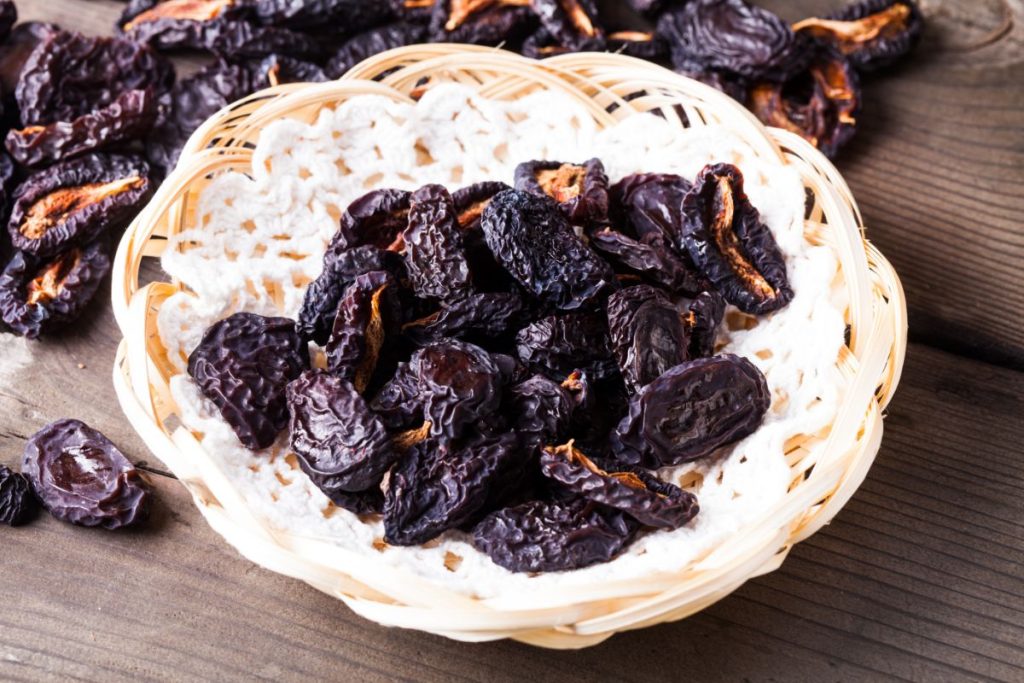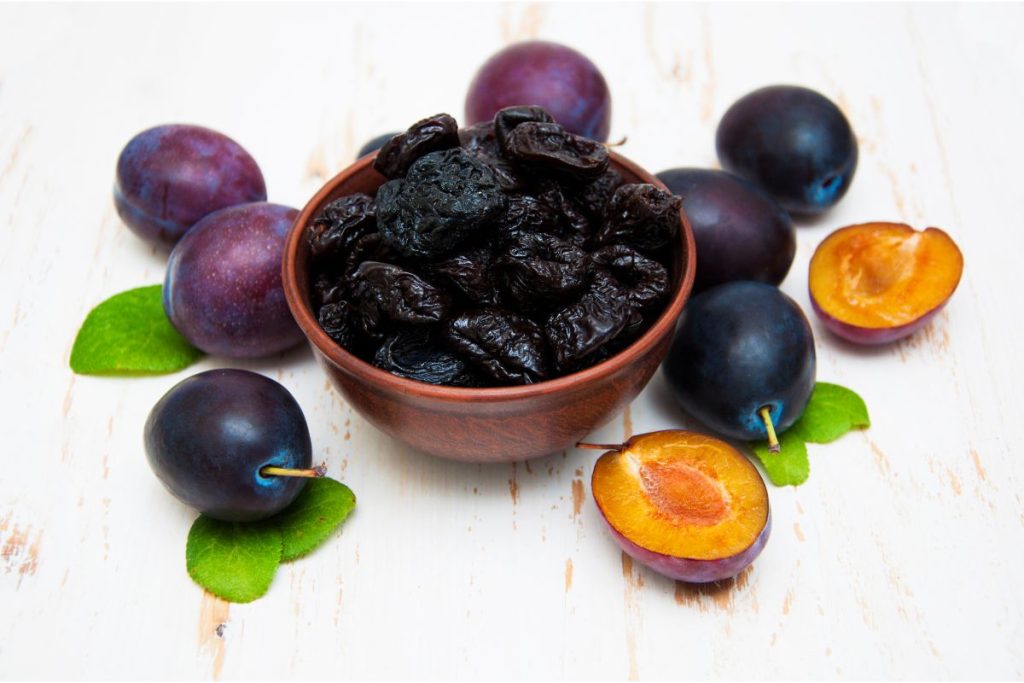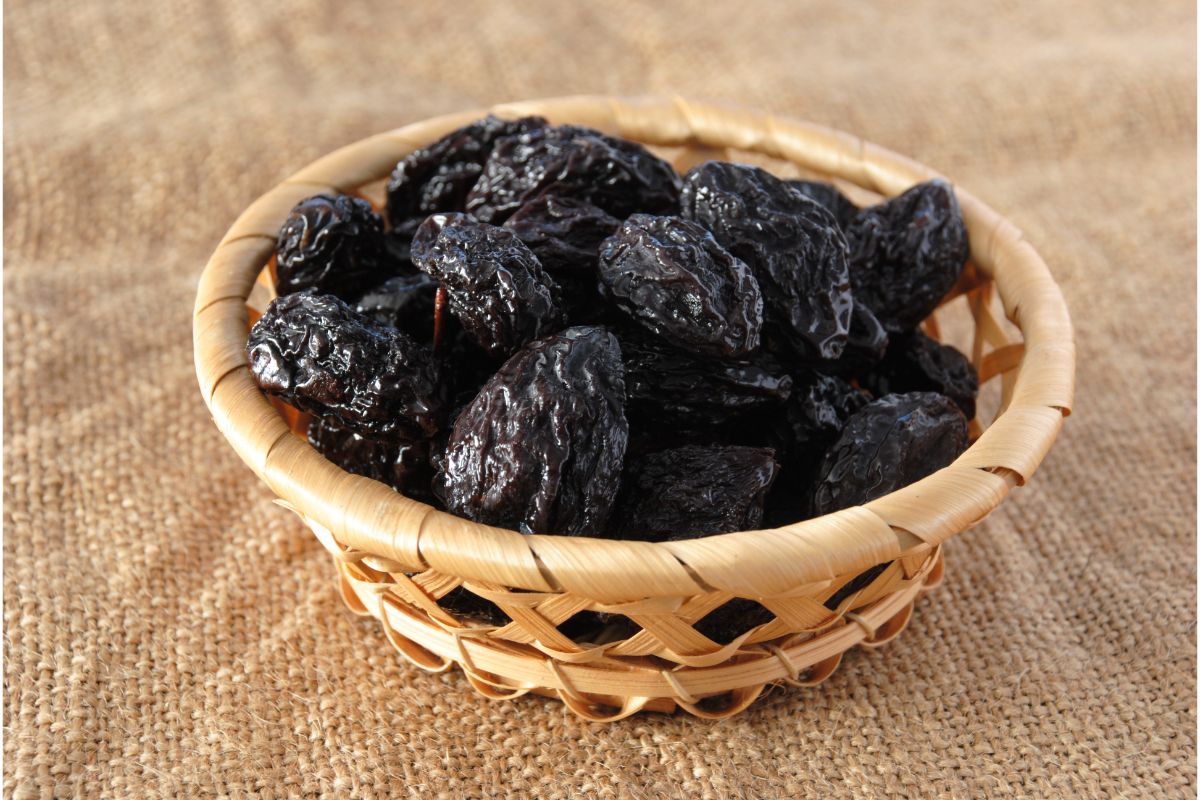When dehydrating plums in the oven, use the oven’s lowest temperature setting and let the plum slices dry for 6-8 hours. Cool dehydrated plums before storing them at room temperature in airtight containers in a cool, dry place.
Table of Contents
How to Dehydrate Plums in the Oven
The fastest way to dehydrate fresh plums is in an oven. Ovens have a higher temperature than food dehydrators which dries fruit faster, but the drying process must be monitored to ensure they don’t burn.
Follow these steps to oven-dry plums:
- Select fresh plums for dehydration. They should be firm, ripe plums that give in slightly when pressed.
- Wash the plums in cold water to remove dirt, pesticides, and bloom (the powdery silver-white lining on the skin). Pat the plums with paper towels to remove water droplets.
- Use a sharp, serrated tomato knife or paring knife to cut the plums in equal halves or quarters. Remove the pits.
- Pre-treat pitted halves or whole plums in a solution made from equal parts water and lemon juice to retain color. Soak them for 3-5 minutes. Remove them from the solution and pat them dry.
- Place the plum halves or quarters in a single layer on a baking sheet lined with baking paper or parchment paper with the cut side face up.
- If you cut the plums in halves, you can pop them to reduce the drying time by increasing the surface area of the exposed flesh. To pop the halves, hold each piece in your fingers with the cut side up, then use your thumbs to push the skin upward to turn it inside-out.
- Dry the plum slices at the lowest temperature setting for 6-8 hours, depending on their size and juiciness. Leave the oven door slightly open to hasten the drying process.
- Check the drying plums every two hours. Most of the drying happens through the flesh, but you can also turn the cut plums over to dry the skin.
- When all the prunes are dry, take out a few pieces and cool them to room temperature. Check for dryness. They should be pliable, leathery, and chewy, with no moisture or stickiness when you squeeze them.
- Cool the dried fruit at room temperature and place them in airtight containers for one week of conditioning. Shake the containers once or twice a day. If no condensation forms inside the container, continue with long-term storage.
- Store the completely dehydrated prunes at room temperature in airtight containers in a cool, dark, dry place.

How Long Does it Take to Dehydrate Plums in the Oven?
Depending on their size, dehydrating plums in the oven takes 6-8 hours. Juicier plums or whole plums may take as long as 18 hours to dehydrate. The total time should take into account a prep time of 20-30 minutes.
What Oven Temperature is Best to Dehydrate Plums?
The best oven temperature for drying plums is the lowest temperature setting. Most ovens have the lowest setting between 125 and 200 degrees Fahrenheit.
Do Plums Dehydrate Well?
Despite their fleshiness and juiciness, plums dehydrate well if you properly dry them in a food dehydrator or oven.
To promote even drying, cut the plums into halves, quarters, slices, or chunks and remove the pits. Smaller sizes ensure a larger surface area which dries fruit faster.

Can You Dehydrate Plums with Pits in Them?
It’s best to dehydrate plums without the pits. Removing the pits exposes more flesh to the heat for faster and even drying.
However, it is possible to dehydrate plums with pits in them if you dry them whole. They must first be heat treated in a process called “checking” to allow internal moisture to escape and speed up drying.
Checking fruits is a short heat treatment to crack the skin of the fruit and remove any natural waxy coating. The skin must be cracked to prevent case hardening, which is common in oven-dried fruits. Case hardening is where the skin hardens outside and traps moisture inside the fruit.
How to Check Prune Plums
- Take small, whole prunes and rinse them in cool water.
- Dip the whole fruits in boiling water for 1-2 minutes.
- Transfer them with a slotted spoon and submerge them in ice water.
- Once cool, remove the plums from the ice water and dab them dry with a paper towel before dehydrating.
What are the Best Varieties of Plums to Dehydrate?
The best prune plum varieties to dehydrate are European plums. European plums are mostly freestone types that are easier to pit as the flesh doesn’t cling to the pit.
European Plum Varieties
You can dehydrate many European types of plums, such as:
- Brooks plums
- Damson plums
- Greengages (such as Laxton’s Gage, Reine Claude, Cambridge Gage)
- Improved French plums (aka La Petite d’Agen plums)
- Italian plums (aka Empress plums, Fellenberg plums, or Blue plums)
- Moyer plums
- Sutter
- Tulare Giant
Japanese Plum Varieties
While most Japanese plums are clingstone (the flesh clings to the pit and is hard to separate), you can use the following freestone Japanese prune plums to make prunes:
- Black Ruby
- Early Golden
- Elephant Heart

How to Store Dehydrated Plums
Store dehydrated plums at room temperature in airtight containers like Mason jars in a cool, dry, dark place.
For long-term food preservation, refrigerate dried prunes after opening their storage container. The refrigerator reduces the chances of oxidation, which causes flavor loss and extends the shelf life of prunes.
What is the Shelf Life of Dehydrated Plums?
According to the USDA, unopened dried plums kept at room temperature have a shelf life of 6 months. Commercial varieties can stay viable for 6-12 months at room temperature.

